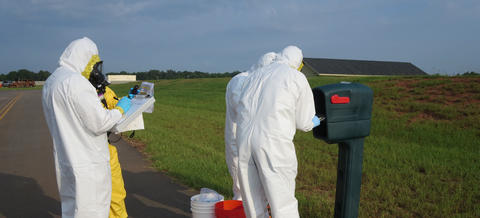
Researchers at the National Institute of Standards and Technology (NIST) have developed a reference material based on baker’s yeast cells – a harmless yet living biological material – that they intend to use for training first responders on biothreats.
“Suspicious powder incidents occur regularly throughout the U.S., so first responders need routine training including simulated biothreat scenarios,” NIST researcher Sandra Da Silva said. “There was a need to make this training accessible while also avoiding exposure to a real pathogen. With support from the Department of Homeland Security, we came up with this yeast reference material to support local training in a safe manner.”
Experts note that biological agents prove a challenge for preparation and training, as the use of actual biothreat materials could pose risks both to the first responders involved and any surrounding communities. Even with care, actual biothreat agents could leave residual material on equipment, causing false positives during real response situations, while the use of inactivated agents could prove unsettling to the public. Hence the desire for a stand-in – in this case, the surrogate NIST Reference Material 8230.
Yeast provides its own challenges, of course. Modern technologies can struggle with its identification due to a similar genetic material to actual biothreat agents. In this case, the yeast reference material was modified with genomic sequences from a deep ocean organism accustomed to extremely harsh temperatures and high-pressure conditions. Researchers chose a specific sequence for this strain because it allowed for the specific detection of yeast using nucleic acid detection technologies, allowing first responders to identify it during training without worrying about false positives caused by other yeast.
“The yeast is alive and surrounded by other materials to protect it during the freezing and drying processes. The four matrix-only vials contain those materials as a control,” Da Silva said. “Once the yeast cells are analyzed, they’re best used to set the baseline for whichever method researchers are using to quantify or detect cells.”
In testing, the substance proved capable of detection even after being crushed into a powder and could be rehydrated and reapplied to various surfaces. NIST also noted the reference material’s potential to help verify the performance of microbial cell counting and nucleic acid detection technologies, making it useful for medicinal work and the study of microbes.
“Microbes are increasingly recognized as critical contributors in many areas of our everyday life, from the environment and climate to human and animal health, agriculture and energy,” Nancy Lin, NIST researcher, said. “The ability to count and characterize microbes is becoming increasingly important as users seek to understand and harness microbial capabilities. We need a control material to increase confidence in microbial quantification for these types of applications.”
Work on NIST Reference Material 8230 is ongoing, but for the moment, first responders have gained a new tool – and other fields may soon benefit as well.




